|
|
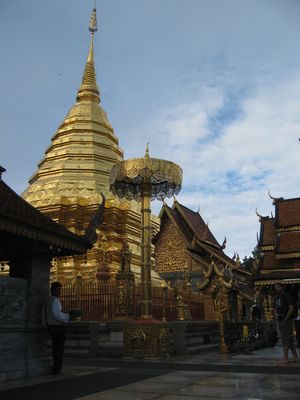
The Golden Stupa at Doi Suthep near Chang Mai |
|
Thailand is the brightest jewel in the crown of Asia that experiences maximum number of foreign footfalls in a year. It lures you with an irresistible natural beauty, breathtaking seashores, lip smacking delicacies and multi-hued cultural settings. Thailand is a melting pot of varieties with warm hospitality of the local population, the tranquil countryside and the jazzy city lives. Formerly known as Siam, the country is situated on the Southeast Asia peninsula. This elongated country’s borders are shared with Laos and Cambodia to the east, the Gulf of Thailand and Malaysia to the South, and the Andaman Sea and Myanmar to the west. Bangkok, a major port, is the capital city of Thailand and Chiang Mai is the second largest city.
Thailand emerged is a constitutional monarchy and enjoyed the highest growth rate in the world during the last decade of twentieth century. The country landscape is densely populated with ethnic Thais dominating the population. Communities from China, India and surrounding Southeast Asian nations comprise the minorities. Thai is largely spoken and written in the country. However, English and some other European languages are also used in urban areas, specifically, Bangkok. Buddhism is the primary religion of the country.
 Ancient towers in Ayuthaya Historical Park
Ancient towers in Ayuthaya Historical Park
|
Geography
Thailand is situated in the heart of the Asian continent over the southward extension of the Malay Peninsula. Geographically, the country can be divided into four natural regions, which include the mountains and forests of the North, the vast rice fields of the Central Plains, the semi-arid farm lands of the Khorat Plateau and the tropical islands and long coastline of the peninsula south. The Chao Phya is Thailand's most important river and flows through Bangkok. This river along with other tributaries drains the central part of the country making it fertile for cultivation. Agriculture, specifically, paddy production flourishes in this part of Thailand rather than the rugged mountainous terrain of the northern sides. The Mekong River borders the plateaus in the east and serves as a major waterway of Thailand. Many big ports have been established the Gulf of Thailand and the Andaman Sea to bolster foreign trade.
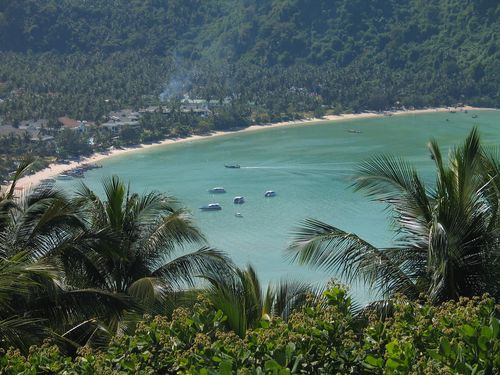 Phi Phi Don Island
Phi Phi Don Island
|
Climate
The climate of Thailand complements the country's thriving agriculture and tourism sector. It is tropical in nature and brings rains with the southwest monsoon in mid May. The atmosphere tends to get dry at the end of the year but catches up high humidity level by the month of January. Except the semi-arid regions on the northeast, Thailand experiences heavy rainfall every year with occasional natural disasters like oceanic storms and floods.
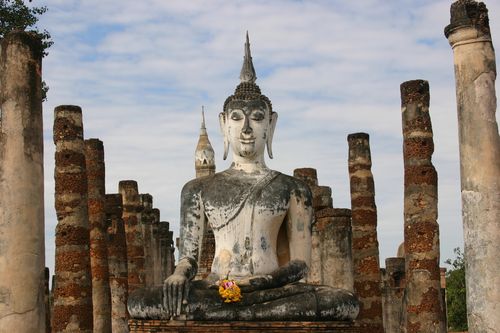 Buddha statue in Sukhothai
Buddha statue in Sukhothai
|
History
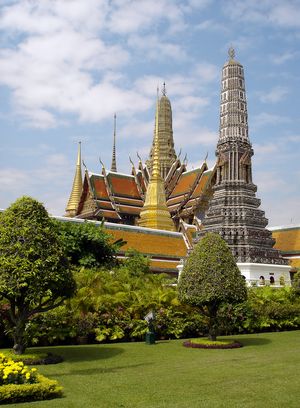
The Grand Palace - Wat Phra Kaew |
|
Thailand has been at the crossroads of migration due to its location in the central part of the continent. Starting from prehistoric times, the country served as a natural gateway to Indochina, Myanmar and Southern China. However, first recorded incidence in the history of Thailand begins with the establishment of the Thai kingdom of Sukhothai in the early thirteenth century. But this rule was short lived and was followed by the reigns of Lanna Thai, Chiang Mai and Ayuthaya. The most amazing part of Thai history is that it was never formally conquered by any foreign ruler, specifically the Europeans. The able rulers of Thailand or Siam, as it was earlier known, fought for centuries with the Cambodians to the east and the Burmese to the west. However, the British spread its influence in the country until the end of the century through the Treaty of Amity and Commerce in 1826. Thailand was an absolute monarchy until 1932 when a bloodless coup led to the country becoming a constitutional monarchy. At the outbreak of World War II, Japanese forces attacked Thailand. By the end of the War Thailand had established a relationship with the USA and was used as an aircraft base by the Americans during the Vietnamese War (1961-1975). Thailand is a member of the United Nations and ASEAN, the Association of Southeast Asian Nations.
Economy
Thailand is often referred to as the “rice bowl of Asia”. This term signifies the nation’s booming agriculture that is dominated by paddy production. Thailand’s fishing industry is another mainstay of the economy that provides food for the population as well as earns foreign currency. Except the financial debacle in the last decade of twentieth century due to the crash in the values of national currency, baht, the country maintained its steady growth rate all along. High rate of tourism, foreign trade and commercial activities are complemented by a free market policy of Thailand.
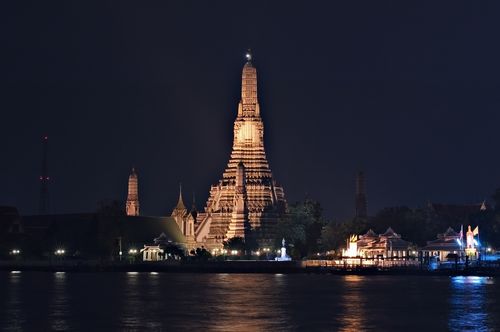 Temple of Dawn - Wat Arun at Bangkok
Temple of Dawn - Wat Arun at Bangkok
|
Politics
Thailand has had a constitutional monarchy since 1932. The bicameral National Assembly or Rathasapha of the country is composed of the House of Representatives and the Senate. Both representatives and senators are elected by the people, the 200 senators serve six year terms whereas the 500 Representatives are elected for four years. The prime minister is the head of state and is elected from among the representatives. The country is divided into 76 provinces. The Bangkok Metropolitan Administration comes under an elected governor. Appointed provincial governors administer the other 75 provinces (Changwat), which are divided into districts (Amphoe), sub-districts (Tambon) and villages (Mu Ban). The Supreme Court or Sandika leads the judiciary of the country.
|
|

